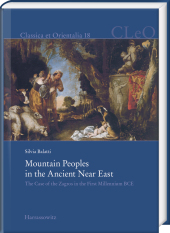 Neuerscheinungen 2017Stand: 2020-02-01 |
Schnellsuche
ISBN/Stichwort/Autor
|
Herderstraße 10
10625 Berlin
Tel.: 030 315 714 16
Fax 030 315 714 14
info@buchspektrum.de |

Silvia Balatti
Mountain Peoples in the Ancient Near East
The Case of the Zagros in the First Millennium BCE
2017. XXVII, 452 S. 18 Abb., 3 Diagr., 1 Schaubilder, 22 Taf., 3 Tabellen. 24 cm
Verlag/Jahr: HARRASSOWITZ 2017
ISBN: 3-447-10800-2 (3447108002)
Neue ISBN: 978-3-447-10800-3 (9783447108003)
Preis und Lieferzeit: Bitte klicken
Since Prehistory, communities principally engaged in herding activities have occupied the intermontane valleys and plains of the Zagros (Western Iran). Relations, tensions and cultural exchange between the inhabitants of the mountains and the Mesopotamian plains already occurred during the Bronze Age. These contacts increased in the course of the 1st millennium BCE, as is suggested by Near Eastern and subsequently by Greek and Latin sources which provide us with numerous new names of peoples living in the Zagros. The present volume investigates the social organisation and life style of the peoples of the Zagros Mountains in the 1st millennium BCE and deals with their relationships with the surrounding environment and with the political authorities on the plains.
Among these peoples, for example, were the ´fierce´ Medes, breeders and purveyors of fine horses, the Manneans, who inhabited a large territory enclosed between the two contending powers of Assyria and Urartu, and the ´warlike´ Cosseans, who bravely attempted to resist the attack of Alexander the Great´s army. The Southern Zagros Mountains, inhabited by mixed groups of Elamite and Iranian farmers and pastoralists, were also of key importance as the home of the Persians and the core area of their empire. Starting from Fars, the Persians were able to build up the largest empire in the history of the ancient Near East before Alexander.
The interdisciplinary approach adopted in this study, which juxtaposes historical records with archaeological, zooarchaeological, palaeobotanical and ethnographic data, provides a new, holistic and multifaceted view on an otherwise little-known topic in ancient history.


